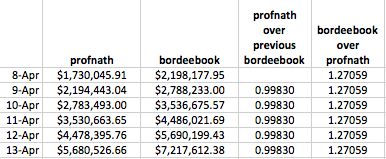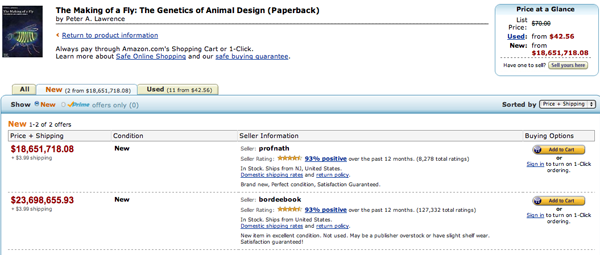A few weeks ago a postdoc in my lab logged on to Amazon to buy the lab an extra copy of Peter Lawrence’s The Making of a Fly – a classic work in developmental biology that we – and most other Drosophila developmental biologists – consult regularly. The book, published in 1992, is out of print. But Amazon listed 17 copies for sale: 15 used from $35.54, and 2 new from $1,730,045.91 (+$3.99 shipping).
I sent a screen capture to the author – who was appropriate amused and intrigued. But I doubt even he would argue the book is worth THAT much.
At first I thought it was a joke – a graduate student with too much time on their hands. But there were TWO new copies for sale, each be offered for well over a million dollars. And the two sellers seemed not only legit, but fairly big time (over 8,000 and 125,000 ratings in the last year respectively). The prices looked random – suggesting they were set by a computer. But how did they get so out of whack?
Amazingly, when I reloaded the page the next day, both priced had gone UP! Each was now nearly $2.8 million. And whereas previously the prices were $400,000 apart, they were now within $5,000 of each other. Now I was intrigued, and I started to follow the page incessantly. By the end of the day the higher priced copy had gone up again. This time to $3,536,675.57. And now a pattern was emerging.
On the day we discovered the million dollar prices, the copy offered by bordeebook was1.270589 times the price of the copy offered by profnath. And now the bordeebook copy was 1.270589 times profnath again. So clearly at least one of the sellers was setting their price algorithmically in response to changes in the other’s price. I continued to watch carefully and the full pattern emerged.
Once a day profnath set their price to be 0.9983 times bordeebook’s price. The prices would remain close for several hours, until bordeebook “noticed” profnath’s change and elevated their price to 1.270589 times profnath’s higher price. The pattern continued perfectly for the next week.
But two questions remained. Why were they doing this, and how long would it go on before they noticed? As I amusedly watched the price rise every day, I learned that Amazon retailers are increasingly using algorithmic pricing (something Amazon itself does on a large scale), with a number of companies offering pricing algorithms/services to retailers. Both profnath and bordeebook were clearly using automatic pricing – employing algorithms that didn’t have a built-in sanity check on the prices they produced. But the two retailers were clearly employing different strategies.
The behavior of profnath is easy to deconstruct. They presumably have a new copy of the book, and want to make sure theirs is the lowest priced – but only by a tiny bit ($9.98 compared to $10.00). Why though would bordeebook want to make sure theirs is always more expensive? Since the prices of all the sellers are posted, this would seem to guarantee they would get no sales. But maybe this isn’t right – they have a huge volume of positive feedback – far more than most others. And some buyers might choose to pay a few extra dollars for the level of confidence in the transaction this might impart. Nonetheless this seems like a fairly risky thing to rely on – most people probably don’t behave that way – and meanwhile you’ve got a book sitting on the shelf collecting dust. Unless, of course, you don’t actually have the book….
My preferred explanation for bordeebook’s pricing is that they do not actually possess the book. Rather, they noticed that someone else listed a copy for sale, and so they put it up as well – relying on their better feedback record to attract buyers. But, of course, if someone actually orders the book, they have to get it – so they have to set their price significantly higher – say 1.27059 times higher – than the price they’d have to pay to get the book elsewhere.
What’s fascinating about all this is both the seemingly endless possibilities for both chaos and mischief. It seems impossible that we stumbled onto the only example of this kind of upward pricing spiral – all it took were two sellers adjusting their prices in response to each other by factors whose products were greater than 1. And while it might have been more difficult to deconstruct, one can easily see how even more bizarre things could happen when more than two sellers are in the game. And as soon as it was clear what was going on here, I and the people I talked to about this couldn’t help but start thinking about ways to exploit our ability to predict how others would price their books down to the 5th significant digit – especially when they were clearly not paying careful attention to what their algorithms were doing.
But, alas, somebody ultimately noticed. The price peaked on April 18th, but on April 19th profnath’s price dropped to $106.23, and bordeebook soon followed suit to the predictable $106.23 * 1.27059 = $134.97. But Peter Lawrence can now comfortably boast that one of the biggest and most respected companies on Earth valued his great book at $23,698,655.93 (plus $3.99 shipping).



30 Comments